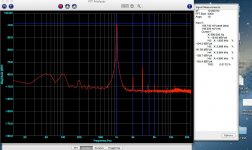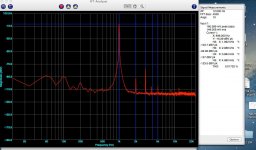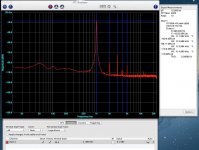Ill talk to a friend and see if he has some extra matched Exicon's and give them a test. I believe they look the most interesting from the outside. But yo know me, Im guessing.
Interesting that these MOSFETs specifically target audio power amplifiers. Claims of high thermal stability will make them useful in diyF5s. If desired a DIYer may build a diyF6 with P-MOSFETs for the right channel and a diyF6 with N-MOSFETs for the left channel of the stereo system. Complementary diyF6s.Just a matter of ordering them from Profusion. Little expensive, but great deal less than SS.
Two I would recommend.
ECW20N20-Z
ECW20P20-Z
No problem with tempco. Use Rs to stabilize the bias and connect to lower end of the transformer windings to the source pins. Thus the AC drive is not degenerated by Rs. The only negative effect of Rs is to slightly limit the maximum current drive to the FET. In a build using the R100s, someone do a test using switches across Rs to see if there is a detectable sonic difference. It would surprise me if there was.
The main issue with the Cree is the temp coefficient. It wil not allow for low or no Rs on the outptut fets. I ebelieve it may be a better alternative than IRF. It will get closer than the Exicon on the gain/Yfs front, but I personally feel that the dropping of Rs is one of the things that defines the sound of this amp. I am working on an output board for the Vfet's. We will try 2sk82 first.
I think the Cree 20120 is probably going away in favor of the new Z FET 80120? just a guess on my part though.What about these:Cree CMF10120D or these CMF20120D Mouser has them in stock.
Will they do? What is the difference between these and the SemiSouth?
Rush
Skipping down the datasheet of both, the new Z FET and the SS, noting the parameters that are good for amps, or at least I look for (Not necesassarily needed in the F6):
Id - SS 17A, 30AMax
80120 20A, 60AMax
Rthjc - SS 1.1 max
80120 .65 max
Pd - SS 136W
80120 208W
C - SS 670pf, 103pf, 97pf, Ciss, Coss, Crss
80120 950pf, 80pf, 6.5pf
Of coarse a real amp listening test would be the ultimate test???
I'ld like to here what others think or have done in this regard. For instance Nelson? have you tested these babies??? 😎
I'm not quite ready to pull out a Benjamin Franklin + for 4 of these guy's just yet but, if we could get the cost down???
There are other parameters I'm forgetting but, the overwelming one is that the 80120 should be available for ~$17 ea. The SS is almost unobtainium 😉
Mouser :
C2M0080120D Cree, Inc. | Mouser
Or in other words, 3/4 of a Franklin 😛
C2M0080120D Cree, Inc. | Mouser
Estimated Dispatch Date
238 17/5/2013
300 10/6/2013
Pricing (EUR)
1: 14,09 €
50: 13,77 €
100: 13,55 €
500: 12,88 €
http://gr.mouser.com/Quote/quote.aspx
Or in other words, 3/4 of a Franklin 😛
I think the Cree 20120 is probably going away in favor of the new Z FET 80120? just a guess on my part though.
Skipping down the datasheet of both, the new Z FET and the SS, noting the parameters that are good for amps, or at least I look for (Not necesassarily needed in the F6):
Id - SS 17A, 30AMax
80120 20A, 60AMax
10120 13A, 49AMax
Rthjc - SS 1.1 max
80120 .65 max
10120 .82 Max
Pd - SS 136W
80120 208W
10120 134W
C - SS 670pf, 103pf, 97pf, Ciss, Coss, Crss
80120 950pf, 80pf, 6.5pf
10120 928pf, 63pf, 7.5pf
Of coarse a real amp listening test would be the ultimate test???
I'ld like to here what others think or have done in this regard. For instance Nelson? have you tested these babies??? 😎
I'm not quite ready to pull out a Benjamin Franklin + for 4 of these guy's just yet but, if we could get the cost down???
There are other parameters I'm forgetting but, the overwelming one is that the 80120 should be available for ~$17 ea. The SS is almost unobtainium 😉
I added the Cree 10120 part:
Id - SS 17A, 30AMax
80120 20A, 60AMax
10120 13A, 49AMax
Rthjc - SS 1.1 max
80120 .65 max
10120 .82 Max
Pd - SS 136W
80120 208W
10120 134W
C - SS 670pf, 103pf, 97pf, Ciss, Coss, Crss
80120 950pf, 80pf, 6.5pf
10120 928pf, 63pf, 7.5pf
They are available at Mouser $20.62, Newark $14.07 each.
Rush
--left picture amp with splitted resistor network in the PSU according to F6 talk
--right picture amp with not splitted resistor network in the PSU
I see no visible difference concerning the higher harmonics of the 50Hz fundamental.....
my 100Hz is fairly high....does anyone know what to do and what is the influence to the sound?
The 50Hz hum is high because of Kimber cables not shielded and the USB sound card itself.
The third picture is from the Masters device, like always much better, how does he do that? He gets better 100Hz and 200 Hz values without any splitting.... ha, ha!


--right picture amp with not splitted resistor network in the PSU
I see no visible difference concerning the higher harmonics of the 50Hz fundamental.....
my 100Hz is fairly high....does anyone know what to do and what is the influence to the sound?
The 50Hz hum is high because of Kimber cables not shielded and the USB sound card itself.
The third picture is from the Masters device, like always much better, how does he do that? He gets better 100Hz and 200 Hz values without any splitting.... ha, ha!


Attachments
Isn't hum a result of imbalance. Perhaps it is his Piltron transformers. How did you get the master version?
Yes, because I have similar differences between my clones and his originals concerning weight and definition I think also in this direction......!
Is anybody here that can report a difference using Plitron against "no name" products?
Is anybody here that can report a difference using Plitron against "no name" products?
the masters versions a always from a diyaudio friend who has a heart for diyaudio fellows to hear at least some time "the masters voice"......
🙂🙂🙂
🙂🙂🙂
I know in tubes, the issue of balance and hum is always more present and dealt with in interesting ways. Also I tihnk about ZV7 and his comment about how many transformers are not truly balanced on their secondaries and in that particular amp, he talked about trimming it. I guess it is reasonable to believe that the nicer the transformer, the more testing they do and perhaps, this is a request of Nelson to them when making them. I am eagerly waiting to hear the Primrose transformers, as they are suppose to be higher quality. I would hope, winding balance is part of that improvement. Still guessing though.
in transformers - things are simple
you make good one , or you make lousy one
bigger core , tight winding , double varnishing , harder baking
you make good one , or you make lousy one
bigger core , tight winding , double varnishing , harder baking
Isn't hum a result of imbalance. Perhaps it is his Piltron transformers. How did you get the master version?
You should note that in The Master's board layout 6moons audio reviews: FirstWatt F6 the Jensen transformers are as far away from the power toroid as possible. He also rotates the toroid to adjust adjust the hum levels.
Thanks Ihquam, all done....🙂
Any idea what higher mains harmonics 100Hz, 200Hz do to the sound? Supposed the mains fundamental is 50Hz.
Any idea what higher mains harmonics 100Hz, 200Hz do to the sound? Supposed the mains fundamental is 50Hz.
Just found this....
"Units fitted with Plitron toroidal transformers have deeper, more powerful bass, sound more musical, more dynamic, more everything that music needs to be exciting and natural-sounding. "
Plitron's Incredible Transformers for Counterpoint
When only the half is true, I would be happy!
"Units fitted with Plitron toroidal transformers have deeper, more powerful bass, sound more musical, more dynamic, more everything that music needs to be exciting and natural-sounding. "
Plitron's Incredible Transformers for Counterpoint
When only the half is true, I would be happy!
- Home
- Amplifiers
- Pass Labs
- F6 Amplifier



